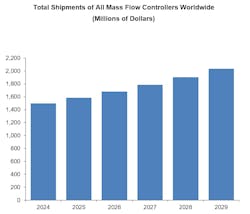Partly driven by shifts in the semiconductor sector, the world market for mass-flow controllers is projected to grow at a 6.3% compound annual growth rate (CAGR) from a total of $1.5 billion in 2024 to more than $2.0 billion during 2029, according to a new study, “The world market for mass-flow controllers," 4th edition, released Jan. 30 by Flow Research.
The study covers both the semiconductor market and the industrial market for mass-flow controllers. It found that, while the semiconductor market is larger, the mass-flow market serves industries that are growing faster. These sectors include lab-grown diamonds, alternative fuels, solar photovoltaic cells and gas distribution. Meanwhile, the semiconductor market is traditionally a cyclical one, often with 12-18-month market cycles. Flow Research reports that suppliers invest in industrial market segments partly to counteract the semiconductor industry’s cycles.
“Mass-flow controllers have a bright future. In the semiconductor industry, increased industrialization will create greater demand for computers, smartphones, wearable technology and electronic devices. While this trend is especially strong in China and the Asia/Pacific region, it applies to other regions as well,” says Dr. Jesse Yoder, president of Flow Research. “In industrial segments, mass-flow controllers are widely used in alternative fuels, solar photovoltaic (PV) cells and fuel cells. The move towards renewable energy will benefit the mass flow controller market. While the industrial market is growing faster than the semiconductor market, all signs point to solid growth in both markets over the forecast period.”
Four different technologies are used in mass-flow controllers: thermal, Coriolis, differential pressure and ultrasonic, with the thermal type dominating the market. In most mass-flow controllers, fluid from a pipe enters the meter, and a portion is diverted into a bypass-capillary tube. The controller measures heat dissipation in the bypass capillary tube with resistance temperature sensors, and uses this value to compute mass flow. They also control mass flow with a proportional control valve that opens or closes based on a setpoint or desired flow. Some mass-flow controllers are shipped without a control function, making them purely mass flowmeters.
Expected expansion areas
Flow Research’s research found that strong growth areas for mass-flow controllers include deployment in clean-energy, hydrogen-measuring applications, such as controlling hydrogen gas in fuel cells and in electrolyzers, as well as in solar-PV cell manufacturing. They’re also essential for battery production, where they control gas flows and enable energy storage. The report adds that automotive, emissions-monitoring, life sciences, alternative-energy, fuel-cells and other manufacturers increasingly use mass-flow controllers to measure and control gas flows in their processes.
The study also reported that demand for mass-flow controllers will continue to come from rapidly growing markets in China, India and Southeast Asia, where demand continues to grow for energy and power, semiconductors and computers, pharmaceuticals, food and beverage, and other products. These rely on increased use of mass-flow controllers during the five-year forecast period. Likewise, in the Middle East and Africa, expanding oil and gas infrastructures and water-treatment plants are driving demands for mass-flow controllers.
About the Author

Leaders relevant to this article:

